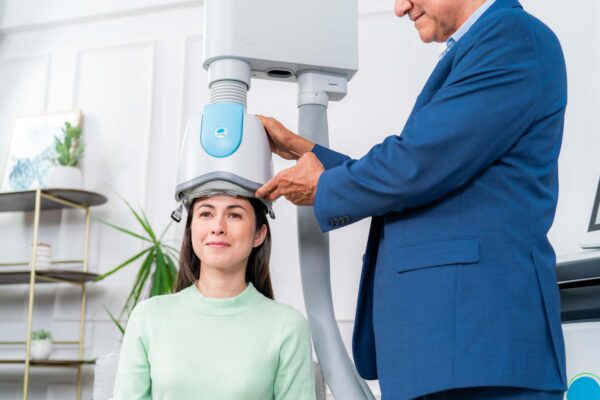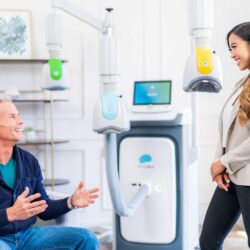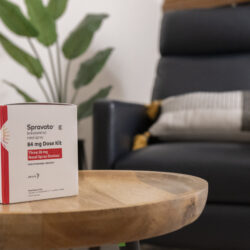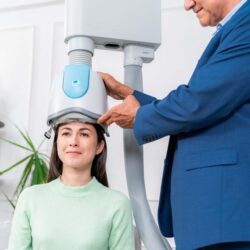
Are you seeking a way to treat depression without a pill? Transcranial Magnetic Stimulation (TMS) is a non-pharmacological option that’s had FDA approval for the treatment of major depressive disorder (MDD) for nearly two decades. In 2018, TMS gained FDA approval for treating obsessive-compulsive disorder (OCD). Whether you haven’t found relief through traditional medications or you’re looking for a non-drug alternative to treat your depression, TMS is a promising solution that may be worth investigating.
While TMS involves brain stimulation, it’s so important for potential patients investigating this treatment to know that it does not include any incisions or direct contact with the brain. It instead uses targeted external pulsations to influence areas of the brain’s circuitry associated with depression symptoms. Here’s a look at how TMS treats depression without medication.
How Does TMS Work?
TMS uses gentle magnetic pulses to target the specific neurocircuitry within the brain that’s responsible for depression. It is increasingly being prescribed as a noninvasive option for people who have treatment-resistant depression that doesn’t respond to standard treatments like medication and talk therapy. The brain is made up of electrical pathways that send information throughout the brain and body. TMS utilizes magnetism to influence electrical activity within specific areas of the brain tied to emotions, pleasure, and decision-making. What does it mean for a person seeking relief from depression?
It is believed that TMS is so effective for easing depression symptoms because it “wakes up” regions of the brain that have decreased activity during depression. In a recent double-blind controlled study conducted at the Stanford University School of Medicine, researchers reported remission of depression symptoms in 79% of trial participants with severe depression after using high doses of magnetic brain stimulation on an accelerated timeline.
What Happens During a TMS Appointment?
At Oasis Mental Health Centers, our team has chosen to use BrainsWay Deep TMS for its advanced technology and data-supported efficacy. Deep TMS systems utilize a coil capable of stimulating deeper and wider swaths of the brain compared to the standard Repetitive Transcranial Magnetic Stimulation (rTMS). BrainsWay Deep TMS has FDA approval for treatment of both major depressive disorder and anxious depression. From the patient’s perspective, BrainsWay utilizes a figure-eight coil for a more comfortable and ergonomic experience. In addition, this system’s deep TMS technology for improved outcomes also shortens treatment times to an average of just 18 to 20 minutes.
Customized Treatment
BrainsWay also allows for greater treatment customization that isn’t always possible with other TMS systems. During a session, the figure-eight electromagnetic coil is placed against your scalp to deliver deep, targeted magnetic impulses that reach deeper into the brain structure to target nerve cells in regions associated with mood control and depression.
Duration
During an initial TMS session, patients undergo a preliminary adjustment stage that lasts 20 to 30 minutes. Also known as motor threshold mapping, this process allows the practitioner to calibrate the locations of brain structures that are pertinent to treatment. Due to the personalization allowed through this form of TMS, the practitioner is also able to adjust the intensity of the magnetic field based on the patient’s response. During treatment, BrainsWay TMS dispatches a magnetic field to stimulate the brain structure being targeted in treatment. For the patient, this involves a series of pulses that are followed by brief intervals of waiting.
Deep TMS treatments can vary in duration based on a patient’s symptoms and the brain structures being targeted. The average protocol for TMS for depression includes an acute phase lasting four weeks and consisting of five sessions a week. Next, treatment pivots into a continuation phase lasting eight to 12 weeks. During this phase, patients typically receive two treatments a week. The total number of treatments during a full course of TMS ranges from 30 to 36 for most patients.
Does TMS Treatment Hurt?
As a noninvasive procedure, TMS treatment does not generally cause pain or discomfort. However, some patients may experience mild pressure or discomfort in the form of tapping or tingling sensations during treatment. These sensations can be expected to subside quickly. The most common side effect of TMS treatment is a mild headache that subsides within a few days. If you experience headaches following TMS, your provider will let you know which over-the-counter pain relievers you can take to manage your symptoms.
If your TMS side effects are disruptive or painful, your care provider may be able to make adjustments to reduce your likelihood of experiencing negative symptoms during or following treatment. In some cases, your provider may advise taking over-the-counter pain medication before each session to prevent discomfort in the first place.
Finding a Way to Treat Depression Without Medication: Your Next Step
For many people struggling with depression, feeling that a pill is the only option care providers can offer you can be discouraging. That’s why FDA-approved TMS treatments are so promising for so many people who are looking for other options. Whether you haven’t received the benefits you want from traditional antidepressant medications or you’re looking for a way to get relief without adverse side effects, TMS treatment for depression may be the breakthrough you’re seeking.
At Oasis Mental Health Centers, we offer a welcoming, supportive environment for patients seeking TMS throughout New Jersey. We offer flexible appointments, custom care plans, and personalized attention. Contact us today to learn more about getting TMS near you in New Jersey.
Sources:
https://pmc.ncbi.nlm.nih.gov/articles/PMC8864803/
https://pmc.ncbi.nlm.nih.gov/articles/PMC10503923/
https://med.stanford.edu/news/all-news/2021/10/depression-treatment.html











